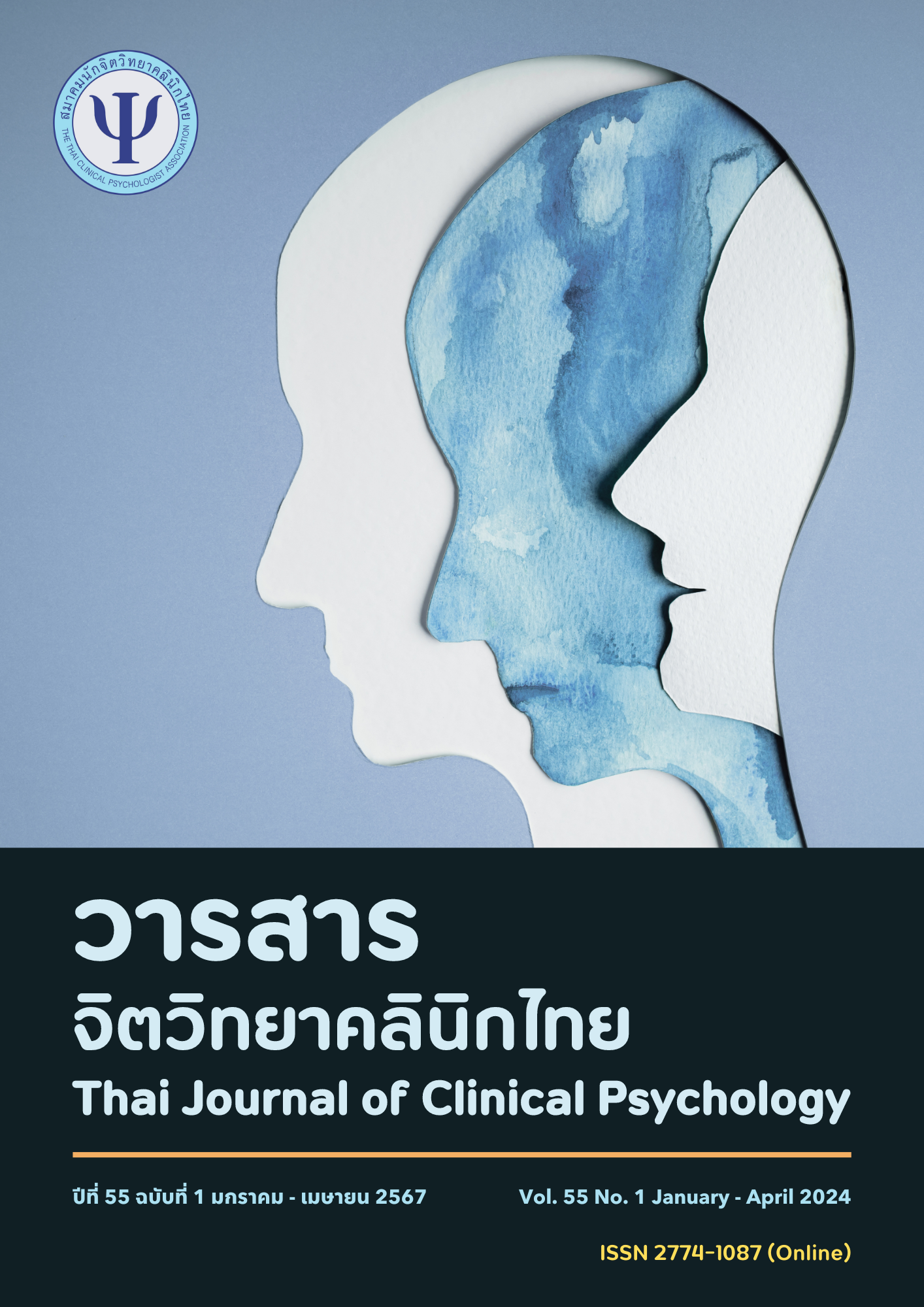ความสัมพันธ์ระหว่างความผูกพัน การผูกมัดในความสัมพันธ์ และการรักษาความสัมพันธ์ของนักศึกษาระดับปริญญาตรี
Main Article Content
บทคัดย่อ
วัตถุประสงค์ เพื่อศึกษาความสัมพันธ์ระหว่างความผูกพัน การผูกมัดในความสัมพันธ์ และการรักษาความสัมพันธ์ของนักศึกษาระดับปริญญาตรี วัสดุและวิธีการ การศึกษาครั้งนี้เป็นการศึกษาแบบภาคตัดขวาง เก็บข้อมูลด้วยแบบสอบถาม ได้แก่ มาตรวัดความผูกพัน (ECR-R-18) มาตรวัดการผูกมัดในความสัมพันธ์และมาตรวัดพฤติกรรมการรักษาความสัมพันธ์ (RMBM)ในนักศึกษาระดับปริญญาตรีจากมหาวิทยาลัยประจำภาคเหนือ ภาคกลาง ภาคใต้ และภาคตะวันออกเฉียงเหนือที่กำลังมีความสัมพันธ์เชิงคู่รักกับเพศตรงข้าม อย่างน้อย 6 เดือนและยังไม่ได้แต่งงาน จำนวน 89 คน วิเคราะห์ข้อมูลโดยใช้สถิติเชิงพรรณนา และวิเคราะห์ค่าสัมประสิทธิ์สหสัมพันธ์แบบเพียร์สัน ผลการศึกษา พบว่า ความผูกพันแบบวิตกกังวลและความผูกพันแบบหลีกหนีมีความสัมพันธ์ทางลบกับทุกพฤติกรรมการรักษาความสัมพันธ์ (r = -.217 ถึง -.617) การผูกมัดในความสัมพันธ์มีความสัมพันธ์ทางบวกกับเกือบทุกพฤติกรรมการรักษาความสัมพันธ์ (r = .23 ถึง .54) ยกเว้นด้านเครือข่ายทางสังคม สรุป หากนักศึกษามีความผูกพันแบบวิตกกังวลและผู้พันธ์แบบหลีกหนีอยู่ในระดับน้อย แต่มีความผูกมัดในความสัมพันธ์อยู่ในระดับ จะส่งผลให้บุคคลแสดงพฤติกรรมการรักษาความสัมพันธ์มากขึ้น ซึ่งจะเป็นผลดีให้สามารถดำเนินความสัมพันธ์นั้นต่อไปได้
Article Details

อนุญาตภายใต้เงื่อนไข Creative Commons Attribution-NonCommercial-NoDerivatives 4.0 International License.
เรื่องที่ลงตีพิมพ์ในวารสารจิตวิทยาคลินิกแล้วถือเป็นลิขสิทธิ์การเผยแพร่โดยวารสารจิตวิทยาคลินิกแต่เพียงผู้เดียว การตีพิมพ์หรือเผยแพร่ซ้ำในที่อื่นต้องได้รับอนุญาตจากกองบรรณาธิการวารสารฯ
เอกสารอ้างอิง
Adams, R. D., & Baptist, J. A. (2012). Relationship maintenance behavior and adult attachment: An analysis of the actor-partner interdependence model. The American Journal of Family Therapy, 40(3), 230-244. https://doi.org/10.1080/01926187.2011.605047
Aristotle. (1885). The politics of Aristotle (B. Jowett, Trans.). Clarendon Press. (Original work published 320 BC)
Ayenew, E. (2016). The effect of adult attachment style on couples relationship satisfaction. The International Journal of Indian Psychology, 3(2), 50-60. https://doi.org/10.25215/0302.041
Baptist, J. A., Norton, A. M., Aducci, C. J., Thompson, D. E., & Cook, A. (2012). Relationship maintenance behaviors: A cross-cultural examination of emerging adults in romantic relationships. Journal of Couple & Relationship Therapy,
(1), 33-50. https://doi.org/10.1080/15332691.2012.639703
Bartholomew, K., & Horowitz, L. M. (1991). Attachment styles among young adults: A test of a four-category model. Journal of personality and social psychology, 61(2), 226-244. https://doi.org/10.1037//0022-514.61.2.226
Browner, W. S., Newman, T. B., & Hulley, S. B. (2013). Estimating sample size and power: Applications and example. Designing Clinical Research, 3, 66-85.
Candel, O.-S., & Turliuc, M. N. (2019). Insecure attachment and relationship satisfaction: A meta-analysis of actor and partner associations. Personality and Individual Differences, 147, 190-199. https://doi.org/10.1016/j.paid.2019.
037
Darling, N. (2018, March 11). Emerging adulthood: The twenty-something stage of life: All grown up but not ready to commit. Psychology Today. https://www.psychologytoday.com/intl/blog/thinking-about-kids/201803/emergingadulthood-the-twenty-something-stage-life
Firestone, L. (2013, July 30). How your attachment style impacts your relationship: What is your attachment style? Psychology Today. https://www.psychologytoday.com/intl/blog/compassion-matters/201307/how-yourattachment-style-impacts-your-relationship
Goodboy, A. K., Dainton, M., Borzea, D., & Goldman, Z. W. (2017). Attachment and negative relational maintenance: Dyadic comparisons using an actor-partner interdependence model. Western Journal of Communication, 81(5), 541-559. https://doi.org/10.1080/10570314.2017.1302601
Hazan, C., & Shaver, P. (1987). Romantic love conceptualized as an attachment process. Journal of Personality and Social Psychology, 52(3), 511-524. https://doi.org/10.1037/0022-3514.52.3.511
Hazan, C., & Shaver, P. R. (1994). Attachment as an organizational framework for research on close relationships. Psychological Inquiry, 5(1), 1-22. https://doi.org/10.1207/s15327965pli0501_1
Jeremy, S. (2020, August 5). Erik Erikson’s stages of psychosocial development explained. Positive Psychology. https://positivepsychology.com/erikson-stages/#intimacy
Kanjanaprakit, K. (2013). Effects of optimism on relationship satisfaction and commitment: The mediating role of positive illusions [Unpublished master’s thesis], Chulalongkorn University. (in Thai).
Le, B., Dove, N. L., Agnew, C. R., Korn, M. S., & Mutso, A. A. (2010). Predicting nonmarital romantic relationship dissolution: A meta-analytic synthesis. Personal Relationships, 17(3), 377-390. https://doi.org/10.1111/j.1475-6811.2010.01285.x
Levinson, D. J. (1986). A conception of adult development. American Psychologist, 41(1), 3-13. https://doi.org/10.1037/0003-066X.41.1.3
Ludden, D. (2017, March 20). The best relationships won't follow the old rules: Responding to your partner's attachment style. Psychology Today. https://www.psychologytoday.com/us/blog/talking-apes/201703/the-best-relationshipswont-follow-the-old-rules
Marianne, S. (2023, October 18). For relationship maintenance, accurate perception of partner's behavior could be key. PHYS.ORG. https://phys.org/news/2023-10-relationshipmaintenance-accurate-perception-partner.html
Mondal, H., & Mondal, S. (2016). Sample size calculation to data analysis of a correlation study in Microsoft Excel®: A hands‑on guide with example. International Journal of Clinical and Experimental Physiology, 3, 180-189. https://doi.org/10.4103/2348-8832.196896
Ogolsky, B. G., & Bowers, J. R. (2012). A metaanalytic review of relationship maintenance and its correlates. Journal of Social and Personal Relationships, 30(3), 343-367. https://doi.org/10.1177/0265407512463338
Pistole, M. C., Roberts, A., & Chapman, M. L. (2010). Attachment, relationship maintenance, and stress in long distance and geographically close romantic relationships. Journal of Social and Personal Relationships, 27(4), 535-552. https://doi.org/10.1177/0265407510363427
Rabby, M. K. (2007). Relational maintenance and the influence of commitment in online and offline relationships. Communication Studies, 58(3), 315-337. https://doi.org/10.1080/10510970701518405
Rusbult, C. E., Agnew, C., & Arriaga, X. (2011). The Investment Model of Commitment Processes. In P. A. M. Van
Lange, A. W. Kruglanski, & E. T. Higgins (Eds.), Handbook of theories of social psychology (pp. 218-231). SAGE Publications.
Stackert, R. A., & Bursik, K. (2 0 0 3 ) . Why am I unsatisfied? Adult attachment style, gendered irrational relationship beliefs, and young adult romantic relationship satisfaction. Personality and Individual Differences, 34, 1419-1429.
Stafford, L. (2010). Measuring relationship maintenance behaviors: Critique and development of the revised relationship maintenance behavior scale. Journal of Social and Personal Relationships, 28(2), 278-303.
https://doi.org/10.1177/0265407510378125
Stafford, L., & Canary, D. J. (1991). Maintenance strategies and romantic relationship type, gender and relational characteristics. Journal of Social and Personal Relationships, 8(2), 217-242. https://doi.org/10.1177/02654075
Stanley, S. M., & Markman, H. J. (1992). Assessing commitment in personal relationships. Marriage and Family, 54(3), 595-608. https://doi.org/10.2307/353245
Weigel, D. J., & Ballard-Reisch, D. S. (2008). Relational maintenance, satisfaction, and commitment in marriages: An actor-partner analysis. Journal of Family Communication, 8(3), 212-229. https://doi.org/10.1080/15267
Wongpakaran, T., & Wongpakaran, N. (2012). A short version of the revised 'experience of close relationships questionnaire': Investigating non-clinical and clinical samples. Clinical Practice and Epidemiology in Mental Health,
, 36-42. https://doi.org/10.2174/1745017901208010036
Wongpakaran, T., Wongpakaran, N., & Wedding, D. (2012). Gender differences, attachment styles, self-esteem, and romantic relationships in Thailand. International Journal of Intercultural Relations, 36(3), 409-417. https://doi.org/
1016/j.ijintrel.2011.12.001
Zeeb, J. (2020, April 28). Levinson's seasons of a man's life. [Video]. Youtube. https://www.youtube.com/
watch?v=ZLE2SITDUOM&t=630s


